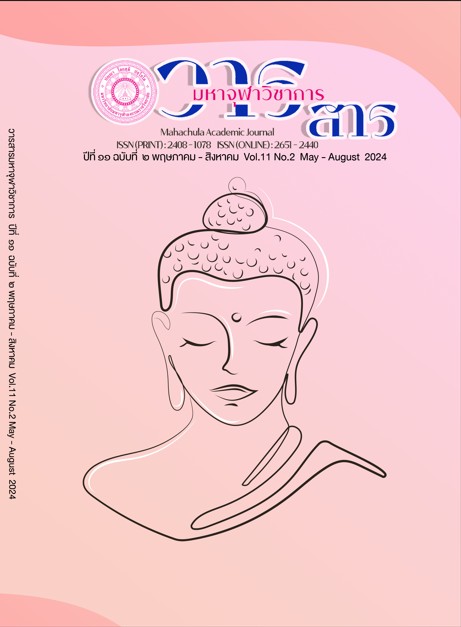Four Brahmavihara, Family Relationship and Psychological Well-being of People at Ladphrao District, Bangkok
Main Article Content
Abstract
The objectives of this research were to: 1) study the levels of Four Brahmavihara, family relationship and psychological well-being of people at of Ladphrao District, Bangkok; 2) compare psychological well-being of people at of Ladphrao District, Bangkok by personal factors; 3) study the relationship between four Brahmavihara and psychological well-being of people at Ladphrao District, Bangkok; and4) study the relationship between family relationships and psychological well-being of people at of Ladphrao District, Bangkok. The samples were consisted of 400 working age people at of Ladphrao District, Bangkok. Data were collected by questionnaires. Data analysis used by a statistical package program. The statistical methods used by percentage, mean, standard deviation, t-test, F-test and Pearson’s product moment correlation coefficient. Results showed that: 1) four Brahmavihara, family relationships and psychological well-being of people at of Ladphrao District, Bangkok were the relatively high level; 2) the people at of Ladphrao District, Bangkok had difference in sex, occupation, income-expense balance and traveling to work had difference psychological well-being with statistically significant at .05 level; 3) four Brahmavihara positively related to psychological well-being of working age people at of Ladphrao District, Bangkok with statistically significance at .01 level; and 4) family relationships positively related to psychological well-being of working age people at of Ladphrao District, Bangkok with statistically significance at .01 level.
Article Details

This work is licensed under a Creative Commons Attribution-NonCommercial-NoDerivatives 4.0 International License.
References
กระทรวงพัฒนาสังคมและความมั่นคงของมนุษย์. ประชากรสูงอายุไทย: ปัจจุบันและอนาคต. กรุงเทพมหานคร: กระทรวงพัฒนาสังคมและความมั่นคงของมนุษย์, ๒๕๖๑.
กวินารัตน์ สุทธิสุคนธ์. “ปัจจัยที่มีผลต่อสัมพันธภาพในครอบครัวไทย”. วิทยานิพนธ์บริหารธุรกิจมหาบัณฑิต. สาขาการจัดการ. บัณฑิตวิทยาลัย: มหาวิทยาลัยมหิดล, ๒๕๖๐.
เกสินี หมื่นไธสง. “การเปรียบเทียบระดับความพึงพอใจในความสุขของประชาชนเขตเมืองและชนบท จังหวัดมหาสารคาม”. วิทยานิพนธ์บริหารธุรกิจมหาบัณฑิต. สาขาการจัดการ. บัณฑิตวิทยาลัย: มหาวิทยาลัยมหาสารคาม, ๒๕๖๐.
พระครูพินิจรัตนากร (อนุสรณ์ ฐานทตฺโต). “การประยุกต์ใช้พรหมวิหารธรรมในการสร้างสันติสุขในอำเภอบางพลี จังหวัดสมุทรปราการ”. วิทยานิพนธ์พุทธศาสตรมหาบัณฑิต. สาขาการพัฒนาสังคม. บัณฑิตวิทยาลัย: มหาวิทยาลัยมหาจุฬาลงกรณราชวิทยาลัย, ๒๕๖๑.
พระพรหมคุณาภรณ์ (ป. อ. ปยุตฺโต). พุทธธรรม. กรุงเทพมหานคร: มหาจุฬาลงกรณราชวิทยาลัย, ๒๕๖๑.
วรัตถ์นันท์ ชุษณะโชติ. “ปัจจัยปกป้องที่มีอิทธิพลต่อความผาสุกทางจิตใจของผู้สูงอายุ”. วิทยานิพนธ์พยาบาล ศาสตรมหาบัณฑิต. สาขาการพยาบาลสุขภาพจิตและจิตเวช. บัณฑิตวิทยาลัย: มหาวิทยาลัยบูรพา, ๒๕๖๑.
ศิริพร เนินสลุง. “ความสุขของประชาชนที่อาศัยอยู่ในเขตเทศบาลตำบลลำนารายณ์”. การค้นคว้าอิสระบริหารธุรกิจมหาบัณฑิต. สาขารัฐประศาสนศาสตร์และบริหารธุรกิจ. บัณฑิตวิทยาลัย: มหาวิทยาลัยรามคำแหง, ๒๕๖๐.
สถาบันพัฒนาการสาธารณสุขอาเซียน มหาวิทยาลัยมหิดล. การพัฒนาชุมชนที่เอื้ออาทรต่อผู้สูงวัย. กรุงเทพมหานคร: มหาวิทยาลัยมหิดล, ๒๕๖๒.
สำนักงานสถิติแห่งชาติ. การสำรวจประชากรผู้สูงอายุในประเทศไทย. กรุงเทพมหานคร: สำนักงานสถิติแห่งชาติ, ๒๕๖๕.
สำนักงานคณะกรรมการพัฒนาการเศรษฐกิจและสังคมแห่งชาติ. ร่างกรอบยุทธศาสตร์ชาติระยะ ๒๐ ปี. กรุงเทพมหานคร: สำนักงานคณะกรรมการพัฒนาการเศรษฐกิจและสังคมแห่งชาติ, ๒๕๖๐).
สำนักงานเขตลาดพร้าว. รายงานประจำปี ๒๕๖๕. กรุงเทพมหานคร: สำนักงานเขตลาดพร้าว, ๒๕๖๕.
Bradburn, N. The Structure of Psychological Well-being. Chicago: Aldine, 1969.


